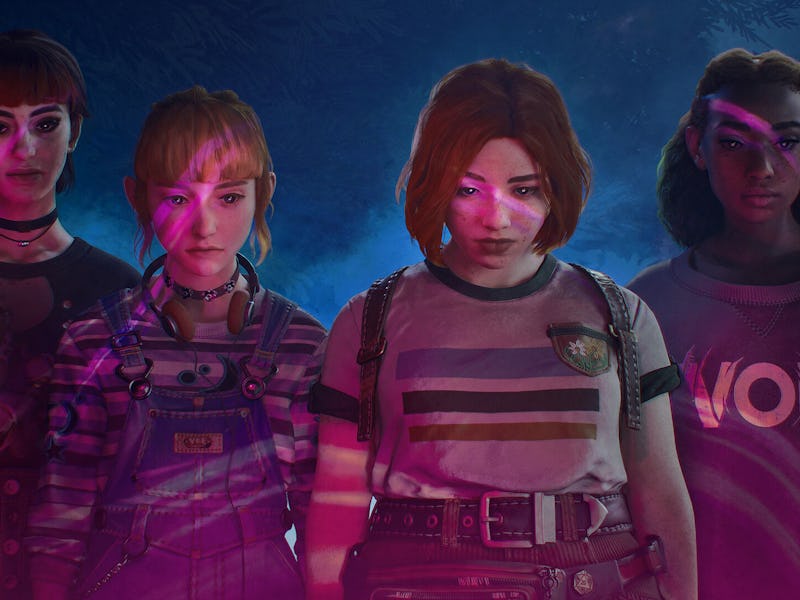Lost Records’ Slow Pace Makes It A Summer To Savor
I know what you did last summer.

I’m in my teenage bedroom, supposedly packing to leave but mostly procrastinating. I try on all the combinations I can of my few sets of pants and shirts, flip through the fantasy books on my shelf, and tell my cat I love him. Before I head out, I capture the scene on my camcorder, preserving a record of this unremarkable day in small-town Velvet Cove, Michigan.
When I say “my teenage bedroom,” I mean Swann’s, the protagonist of Lost Records: Bloom and Rage - Tape 1. So why does it feel so achingly familiar?
As its mouthful of a title implies, this is a game in two parts. Tape 1 is out today, and Tape 2 concludes its story on April 15. Swann is the first character we meet in Lost Records, as she has a frustratingly relatable quasi-fight with her mom on the phone while sitting in her car. Swann has returned to Velvet Cove to reunite with a group of friends she met in 1995 and hasn’t seen once in the subsequent 27 years, after a mysterious incident centering in the town’s woods when they were teens.
Lost Records’ teen characters are almost painfully relatable at times.
Aside from brief framing segments as Swann and Autumn reconnect as adults, the rest of the game is a slow-paced slice-of-life story following the friend group through a month of summer break together. Rather than delving into the spooky goings-on in Velvet Cove, Tape 1 keeps a narrow focus on Swann and her friends. Swann is a loner as the story opens, spending her days filming everyday life in Velvet Cove on her own. While on a trip to return a move to the video store, she runs afoul of a couple of local bullies, before a group of girls she’s never met comes to her rescue. From that moment on, Swann forms a tight bond with bandmates Nora and Autumn, as well as Kat, a fellow loner who’s just as into the supernatural as Swann herself is.
You’ll spend most of your time in Lost Records guiding Swann through conversations with her friends through one of the better dialogue systems I’ve seen in a game. Almost every dialogue choice comes with a time limit — let it run out, and Swann will stay silent, which may end up actually being the best option sometimes. Some choices, mostly those that might be embarrassing or contentious, disappear much quicker than others, as if Swann lacks the courage to commit to expressing them. Sometimes options will remain locked until you look around the scene to find the right clue, and some only appear after other choices have disappeared. It’s a system that makes you think hard about what options you have in each conversation, and conveys some of the difficulty of expressing yourself as a teenager around new friends, especially since most options will impact your relationship with them in some way.
The friendship between its protagonists is Lost Records’ greatest strength.
Lost Records’ other major mechanic stems from Swann’s trusty camcorder. At any time, you can bring the camcorder up and start recording. Collect enough clips of a single subject and you can arrange them into a compilation tape focused on one character, location, or idea (my favorite is just called “Birds!”). Occasionally you need to record certain subjects to advance the plot, which can turn the game into a bit of a slog as you hunt for everything you need and fight with the camera to register the right subject when multiple potential focuses are in view. Otherwise, it’s a totally optional activity that rewards you for paying attention to details and offers a twist on typical photo modes — Lost Records has an excellent one, by the way.
It’s not mechanics that really endeared me to Lost Records, though. In 1995, when the game’s cast attended high school, I was in elementary school. And while the protagonists are teenage girls, I wouldn’t come out as a trans woman until my mid-30s. But from the first scene in Swann’s room, I felt a connection to her so strong it hurt. Everything from her awkwardness and penchant for documenting her life to the X-Files posters, books on local legends, and even the bug she keeps as a pet in her room reminded me of myself as a child. More than that, I felt like Swann is exactly the kind of girl I would have been, had I known that’s what I was at the time.
The supernatural mystery in Lost Records is no closer to being solved by the first part’s end.
Lost Records can be cloying at times, but even in its most on-the-nose moments, I was won over by its earnestness. It’s a celebration of sisterhood, treating its characters with respect even in their most awkward, embarrassingly sincere moments. Rather than a supernatural mystery with teenage protagonists, it’s more akin to a summer break simulator with magical undertones.
Lost Records ends with a twist that seems to come out of nowhere and frankly feels more like a manipulative way to raise the stakes than an effective setup for part two. This first episode lacks any real arc of its own, leaving it as something of a prelude for what’s to come. But setting aside how it functions in the context of the larger story, it’s a delightful and moving look into the lives of four teenage girls that I loved almost every moment of. Whatever comes in the game’s second half, I’m glad I got another chance to enjoy the summer of ‘95.